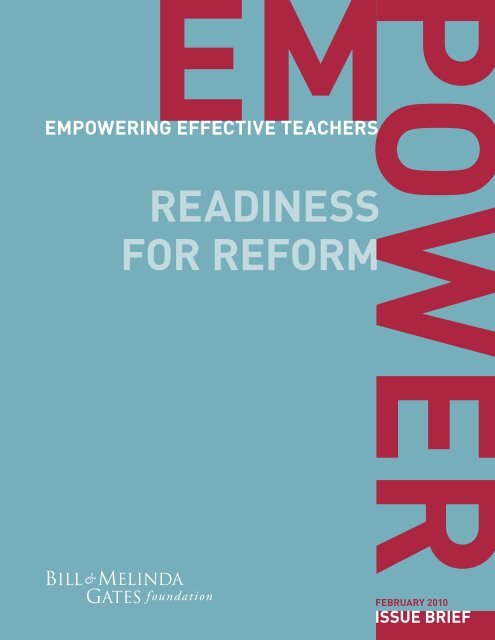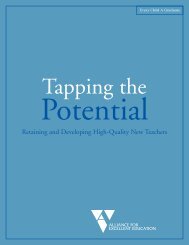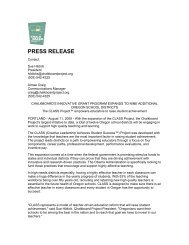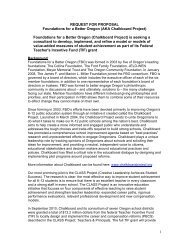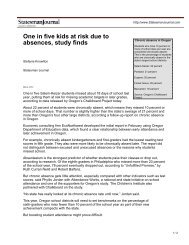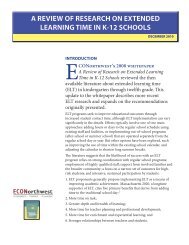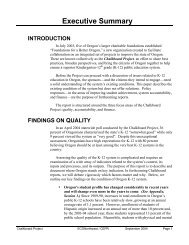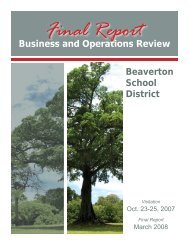Empowering Effective Teachers - The Chalkboard Project
Empowering Effective Teachers - The Chalkboard Project
Empowering Effective Teachers - The Chalkboard Project
Create successful ePaper yourself
Turn your PDF publications into a flip-book with our unique Google optimized e-Paper software.
EMPOWERING EFFECTIVE TEACHERSEMPOWERING EFFECTIVE TEACHERSREADINESSFOR REFORMOWERFEBRUARY 2010ISSUE BRIEFREADINESS FOR REFORM1
EMPOWERING EFFECTIVE TEACHERSREADINESS FOR REFORM
EMPOWERING EFFECTIVE TEACHERS<strong>The</strong> request for proposals did not stipulatespecific strategies for improvement, butin the course of their planning, the sitesidentified many of the same strategies,including: adopting multidimensional mea-sures of teacher effectiveness,including measurements of students’academic growth over time creating better teacher evaluationtools and processes that strengthenthe leadership and evaluation skills ofprincipals, provide specific feedbackto help teachers improve practice, andgenerate targeted professional developmentopportunities making the tenure decision a moremeaningful milestone, using theimproved teacher effectiveness measuresand evaluation processes to createa rigorous process for granting tenureand increasing the reward for thoseeffective teachers who earn tenure designing career pathways and dif-ferentiating compensation, so thateffective teachers can be rewarded fortheir work in the classroom based onperformance rather than longevity ordegree attainment attracting and placing highly effec-tive teachers in priority schools orclassroomsA PATHWAY TO EFFECTIVE TEACHINGAs identified by participating sites2READINESS FOR REFORM
EMPOWERING EFFECTIVE TEACHERSINTRODUCTIONEvery student deserves to be taughtby an effective teacher. Ensuringan effective teacher in every classroom,every year, is the primary responsibility ofevery school system in this country and thekey opportunity for transforming educationtoday. Once school systems make acommitment to this reform endeavor, theyneed to assess their level of readiness—diagnosing the conditions that support orinhibit reform and mapping a path forwardbased on the conditions, current context,and capacity they find. By objectively determininga starting point, a school systemcan shape a course of action to addressgaps, build on strengths, and improve theprospects for success.Each site that participated in teachereffectiveness planning over the summerof 2009 engaged in a rigorous assessmentof its own environment. While the siteswere at different levels of readiness, theysurfaced many of the same conditionsrequired for advancing teacher effectivenessinitiatives. <strong>The</strong>se conditions fall intofour distinct categories and represent aminimum readiness threshold that all sitesshould consider—or seek to achieve—before embarking on deep reform. <strong>The</strong> fourcategories are: a culture of data-driven decision-making, with high-quality, robust datasystems and evidence of usestakeholder engagement, including acommitment to collaborate with internaland external stakeholders policies that support, or at a minimumdo not restrict, improvement effortsIn addition to illustrating specific readinessfactors in each of these categorieswith examples from the sites, this paperincludes rubrics that illustrate a continuumof readiness for the four categories andguidance on what constitutes a base level ofreadiness. <strong>The</strong> rubrics are drawn from theexperiences of these sites as well as knowledgegained from other reform efforts.<strong>The</strong> 10 sites began their planning processesfrom very different starting points.Some sites had limited working relationshipswith their teachers’ unions, whileothers had a deep history of effective siteunioncollaboration. Sites in some statesbenefited from strong state data systemsand policies that support student-teacherdata linkages. Some sites were broachingthe idea of value-added metrics for thefirst time.DataCultureLeadershipAlignmentReadinessPolicyEnvironmentshared leadership, vision, and com-mitment to action, with the creation ofa core group of site leaders, teachersand their unions, and school boardto develop and define the vision ofteacher effectivenessNo matter where they started, every siteemerged from the proposal process withan explicit plan to implement far-reachingreform strategies to empower effectiveteachers, including strategies to mitigateor improve on the conditions of readiness.StakeholderEngagementREADINESS FOR REFORM5
EMPOWERING EFFECTIVE TEACHERSSHARED LEADERSHIP, VISION,AND COMMITMENT TO ACTIONShared leadership“… we didn’t have a strong workingrelationship with the union, so trust was asignificant factor. We spent a lot of upfronttime on process and building trust … .”Each of the 10 sites emphasized the valueof collaboration in determining the directionof teacher effectiveness initiatives, thestrategies to use, and the measurementsto evaluate progress. A core group of site,school board, union, and classroom leadersshared the responsibility for this initialbrainstorming phase, with some groupsmeeting as often as every week to discussand explore possibilities.This collaborative effort of district leaders,unions, and school boards proved essentialto building and maintaining a basiclevel of trust; developing a common strategicvision of teacher effectiveness goals,definitions, and priorities; and creatingsupport for the basic principles and valuesof teacher effectiveness strategies.Making teacher effectivenessa high priority“This [teacher effectiveness] initiative mustbe one of the few top initiatives that a siteundertakes for the next few years … .”Site leaders demonstrated that teachereffectiveness was a high priority intwo very visible ways: by allocatingoften scarce resources—their time andteams— to support and actively participatein key decision processes. Many siteschose to reallocate resources from otherinitiatives that they deemed less critical toensure an appropriate allocation of time,money, and other resources to supporttheir teacher effectiveness agendas.A reliable way to measure commitment isto observe who attends meetings in whichthe issue is discussed. Who has made this apriority on an overscheduled day? Sites withhigh levels of commitment assign responsibilityfor oversight to those who reportdirectly to the superintendent; sites bestprepared for this work have leaders who cansupport a clear strategic vision by applyingpractical skills in project management andpolitical expertise, thus accelerating keydecisions and navigating obstacles. One site noted the importance ofdevoting necessary senior staffresources and time to both the teachereffectiveness planning process andongoing implementation. One site, together with the schoolboard, eliminated a number of lowerpriorityreforms to redirect the necessaryresources to these initiatives.Another site credited its success to theamount of time site leaders investedin working with the union and schoolboard to ensure that teacher effectivenessbecame a joint priority.6READINESS FOR REFORM
EMPOWERING EFFECTIVE TEACHERSSome sites demonstrated more inter-mediate or advanced readiness levelsby having effective organizationalinfrastructure and operating efficienciesacross human resources, finance,school operations, transportation, andother key central office functions.Commitment to action“Prior to this planning effort [with thefoundation], we had never really thought ofgoing after such aggressive reforms. Thisprocess was a catalyst for our site to act inways that we would not—and could not—have done without [engaging in a processlike this.]”<strong>The</strong> 10 sites say that superintendents,leadership teams, and union and schoolboard partners must be willing and able tochallenge many deeply ingrained practicesand value systems. Many teacher effectivenessreforms rely on innovative practicesthat represent a major threat to the statusquo, such as compensation tied to studentachievement growth over time rather thanthe number of academic degrees a teacherearns or years in the classroom.<strong>The</strong>se sites understand that pursuing boldreform requires strong district leaderunion-schoolboard relationships throughperiods of strain and controversy. At aminimum, sites must be willing to askdifficult questions that challenge currentsystems and practices. One site creditsthe dedicated planning process withsufficiently strengthening the districtunionrelationship to enable discussionsof reform: “Over the three months ofplanning, both [the district’s and theunion’s] mindsets evolved. <strong>The</strong> union hadalways been ready to defend teachers atall costs, but through this process we seethat we’re all in this together and we havebecome more proactive,” said one leader.Across the foundation’s 10 partnershipsites, all leaders were universallyopen to conversations that challengedlong-standing conventions of teacherquality. In sites at earlier stages of readiness,leadership made critical progress inbuilding the necessary foundation forreform.Sites with higher levels of readinesshave gone beyond conversations todeveloping targeted initiatives such asincentive and performance pay.Sites with higher readiness levelsoften can point to examples of otherreform success that came not onlyfrom effective implementation butalso from the ability to review incrementalprogress, make mid-courseadjustments, and demonstrate measurableand meaningful outcomes.READINESS FOR REFORM7
EMPOWERING EFFECTIVE TEACHERSDefinition of teachereffectiveness“When our pay-for-performance initiativebegan, we had disagreements withthe teachers’ union over tying data toteachers. Now that we’ve resolved thatissue, it’s much easier to talk about teachereffectiveness.”... growth in student achievement over time is amajor component in defining teacher effectiveness.Once members of the core group havefound the meeting room and seats at thetable, the first questions they ask are oftenthe same, no matter where the discussionis taking place in the country: What do wemean by teacher effectiveness? Are wetalking about evaluating teachers basedon student performance? Hiring highlyqualified teachers? Better evaluation processes?An important readiness criterionis the recognition that growth in studentachievement over time is a major componentin defining teacher effectiveness.<strong>The</strong>se 10 sites acknowledged theimportance of working on a conciseand clear definition of teacher effectivenessto lay the groundwork foridentifying specific strategies andcreating plans to implement them.Sites that already have engaged inactive dialogue about teacher effectivenesstend to be more ready forreform than sites with limited experiencein making teacher effectivenessa key strategic priority.Many sites have undertaken discreteand often site-wide initiatives relatedto teacher effectiveness that supportedthe effort to reach a consensusdefinition of what an effective teacherlooks like. While sites with a history of inter-nal and external discussions aboutteacher effectiveness benefited fromhigher readiness levels, the quality ofthe discussion and the definition thatresulted also were important.8READINESS FOR REFORM
EMPOWERING EFFECTIVE TEACHERSSpectrum of Readiness To Engage in Shared LeadershipEarlyDistrict Readiness ContinuumAdvancedCommonLeadershipVision andWillingness ToCollaborate(District-Union-SchoolBoard) Little history of district-union-school boardcollaboration Low receptiveness toteacher effectivenessvalue and/or principles Inconsistent vision forteacher effectivenessneed and/or value Some history of effectivedistrict-union-school boardcollaboration Base level of trust amongdistrict-union-school board Shared values forimportance of teachereffectiveness strategies Willingness to crafta common teachereffectiveness vision Strong history of deep andeffective district-union-schoolboard collaboration Past collaboration includesdiscrete teacher effectivenessinitiatives Common and explicit visionfor teacher effectivenessstrategies shared by districtunion-schoolboardCommitmentto/Capacityfor Teacher<strong>Effective</strong>nessPrioritization District over-commitment tonumerous initiatives Lack of clearprioritization acrossdistrict initiatives No clear accountabilityfor teacher effectivenessoutcomes Limited superintendent/leadership engagement Teacher effectiveness isone of a select number ofdistrict priorities Targeted and capablecentral office resourcescommitted to teachereffectiveness Clear central accountabilityfor teacher effectivenessoutcomes Superintendent andleadership team committedto monthly teachereffectiveness meetings anddeliverables Teacher effectiveness is the topdistrict priority Dedicated and capable centraloffice resources committed toteacher effectiveness Clear and measurableaccountability for teachereffectiveness outcomes Superintendent and leadershipteam actively participate in andcontribute to regular workingsessions (weekly or biweekly)LeadershipOrientationfor Reform Low/limited leadershipwillingness for reform History of limited and/orincremental changes Unclear and/orundefined vision fordistrict progress Joint work with district-union-school board todevelop targeted teachereffectiveness initiatives(e.g., bonus plans) Articulated vision for districtprogress includes targetedareas for significant changeand emphasizes studentachievement High leadership willingness toundertake major reforms andchange ingrained practices District vision for progressincludes high-priority areas forreform aligned with a singularfocus on student achievement<strong>The</strong> readiness factors in these rubrics have been observed in the 10 participating sites, as well as in other districtsinvolved in similar reform efforts, and are intended to guide districts intent on creating the conditions for successfulimplementation of teacher effectiveness reforms.READINESS FOR REFORM9
EMPOWERING EFFECTIVE TEACHERS One site credited the formal andinformal use of data in conversationswith principals and school leaders forits success in defining and evaluatingaccountability targets linked to schoolperformance bonuses.<strong>The</strong> sites with the highest levels ofreadiness have a culture of data use thatextends beyond site leadership. <strong>The</strong>yengage the school board, union, principals,and teachers in ongoing dialogue, decisionmaking,implementation, and accountabilityefforts, with data informing all discussions.Performance metrics and dashboards tendto be used systemically, not only to guideand adjust implementation activities butalso to engage and communicate progressto a broad group of stakeholders.Whatever their stage of readiness, thesesites recognize that a strategic use of datarequires them to: acknowledge the importance of data instrategic decisionmaking and perpetuatethis value in practices in the centraloffice, schools, and classrooms educate stakeholders in how and whydata are used to support decisionmaking build widespread acceptance of data-driven decisionmaking by making it acommon practice develop their organizational capacity toanalyze, understand, and use data forstrategic (versus compliance) purposesData quality, availability,and integration“Having the groundwork laid for ourdata warehouse prior to the teachereffectiveness proposal has been extremelyhelpful in accelerating our teachereffectiveness efforts.”A school district’s ultimate level of readinesswill vary depending on data quality,availability, and the integration of differentsystems. <strong>The</strong> basic data requirementsneeded to measure teacher effectivenessaddress multiple issues.Data Elements Unique IDs for students, teachers, andcourses that are consistent over time andacross disparate data systems Link between teachers and studentsAvailable student standardized test scores,i.e., end of grade (3–8 at least), benchmarkassessments, or state/national tests thatmeasure growth over time Student and teacher demographiccharacteristics Human resources/teacher backgroundinformationRationale for Importance Necessary for tracking progress over time Key to determining whether strategies arebenefiting all student groups equally Must be linked to measure a teacher’svalue-add Can help determine predicted growth andvalue-added scoresThrough further research, can helpdetermine characteristics of successfulteachersREADINESS FOR REFORM11
EMPOWERING EFFECTIVE TEACHERSClearly, the ability to link student andteacher data is a necessary prerequisite—if not the linchpin—to define and measureteacher effectiveness. Since there wereno legal barriers to linking student andteacher data for the participating sites, theyhave cleared a major readiness hurdle.<strong>The</strong>ir next step is to assess whether theyhave taken advantage of this opportunityto measure teacher effectiveness. Schoolsystems with barriers to linking studentand teacher data must evaluate the effortrequired to remove such barriers and/or alternative means to develop relevantteacher effectiveness measures.... the ability to link student and teacher data is anecessary prerequisite—if not the linchpin—todefine and measure teacher effectiveness.In addition to policy or legal barriers,other data issues can present challengesto teacher effectiveness strategies. Forexample, it can take significant time,energy, and skill to identify and integraterequired data elements if data systemsdo not communicate well. Handwrittenteacher evaluations require substantialeffort to upload for integration with otherdata elements. Outdated human resourcesdata systems create headaches for thosetrying to link personnel records withstudent records. Some teacher effectivenessmeasures are qualitative—classroomobservations, peer reviews, studentsurveys—and are difficult to convert to aconsistent scale.Another hurdle is the availability of regular,standardized student assessment measures.NCLB requires annual testing ingrades 3–8. Where these tests are rigorous,robust, vertically aligned, and alignedto state standards, and where results arereturned in a timely manner, districts areat an advantage.<strong>The</strong>se challenges underscore a broader setof systemic practices and processes thatmake it difficult for stakeholders to accessand use data. Many school systems lacksystematic operating procedures to defineand monitor how student data are enteredat the school level. As a result, the qualityof school-level data that are uploaded tosite data systems is unreliable, which canmake a reform effort such as this more difficult.Participating sites that demonstratea higher level of readiness have strong datagovernance and operating procedures thatare driven by school leadership and auditedat the central office level.12READINESS FOR REFORM
EMPOWERING EFFECTIVE TEACHERSSpectrum of Readiness To Use Data for DecisionsEarlyDistrict Readiness ContinuumAdvancedStrategic Useof Data Compliance-drivenculture of data usage Limited use of datato inform strategicpriorities and/ordecisions “Data-weary” districtculture Targeted use of data toinform a district’s strategicpriorities and actions Inconsistent use of data-driven decisionmakingoutside of the central office Principals review studenttest data on an annual basisto diagnose key learningissues Strategic use of data is coreto the district’s operatingprinciples Systemic approach to datausage (central office to theclassroom) to measure andimprove performance Monthly school-level review ofinterim student assessmentdata to inform immediatestudent learning strategies Central office use of hiring datato inform teacher placement Dedicated central officeresources for strategic use ofdataData Quality,Availability,andIntegration Limited level of statestudent testing data Little formalized districttest data No unique student IDs Inability to linkdatabases and/orsystems State and/or district testdata Unique student IDs Ability to link student dataacross different systems Ability to link student andteacher data Pre-existing state or districtlongitudinal data system withintegrated historical studentand teacher data and uniqueIDsDefinition andUse of Teacher<strong>Effective</strong>nessMeasures Limited prior efforts todefine and/or measureteacher effectiveness Limited active dialogueon teacher effectiveness(both internal andexternal to district) Preliminary efforts to defineteacher effectiveness viatargeted input from centraloffice leadership, teachers,and principals Active district-union-schoolboard discourse on teachereffectiveness importance Preliminary and/or piloteduse of select teachereffectiveness measures(e.g., incentive pay, etc.) Explicit district teachereffectiveness definition derivedvia multi-stakeholder input Pre-existing value-add datalinking student and teacherdata History of broaderimplementation of targetedteacher effectivenessinitiatives (e.g., incentive pay,differentiated comp)<strong>The</strong> readiness factors in these rubrics have been observed in the 10 participating sites, as well as in other districtsinvolved in similar reform efforts, and are intended to guide districts intent on creating the conditions for successfulimplementation of teacher effectiveness reforms.READINESS FOR REFORM13
EMPOWERING EFFECTIVE TEACHERSSTAKEHOLDER ENGAGEMENTInternal stakeholderengagement“I don’t know how a site could get throughthis [planning process and strategyimplementation] without a great unionrelationship that is built on trust.”Sites that were best able to accelerate reform hadestablished the precedent of working with their unionsand school boards to solve meaningful problems.From the perspective of internal site constituents,engagement of the local teachers’union and school board greatly enhancesthe depth and strength of an initiative. Sitesthat were best able to accelerate reformhad established the precedent of workingwith their unions and school boards tosolve meaningful problems.senior-level district leadership andregular—and intense—working sessionsamong the district, union, andschool board leadership, the threeparties built a foundation of trust.Principal and teacher engagement isan equally important readiness factor.Principals have the ultimate responsibilityfor implementing many components ofteacher effectiveness strategies and forbuilding trust with teachers so that theyunderstand and support reforms. <strong>The</strong>y alsoare gatekeepers for critical student andteacher data, much of which are input intosite data systems from the school level.Other readiness factors here includeprofessional development for principals onteacher evaluation and formal processesfor soliciting teacher input in definingteacher effectiveness and its measures.14READINESS FOR REFORM One district with a “great” site-unionrelationship and a “multiyear” historyof collaboration had already negotiatedperformance and incentive payin its teachers’ contract. This allowedthe site to accelerate its teacher effectivenessplanning efforts.Districts in the process noted that acommitment to address teacher effectivenessreforms also can encouragedistrict-union-school board collaborationin sites with limited prior workingrelationships. One district and union used the plan-ning process to foster a much strongerworking relationship. Guided by One superintendent schedules regularvisits with principals, teachers, andschool leadership teams to discussongoing efforts. <strong>The</strong> site credits thiseffort with teachers feeling connectedto both the central office and thebroader teacher effectiveness initiative. One site conducts ongoing teachereducation to explain specific teachereffectiveness measures and communicatesto teachers the broadercareer benefits and implications of theinitiatives.
EMPOWERING EFFECTIVE TEACHERSExternal stakeholderengagement“We weren’t quite prepared for the requiredlevel of external stakeholder engagement—this required a much greater effort than wehad done in the past.”Site readiness is affected by the scale anddepth of relationships with external stakeholders,as well as the local landscape ofsite-community relationships. Sites witha strong history of broad external stakeholderengagement are further along thereadiness continuum. In one site, communityleaders played a pivotal role inadvocating for placing the best teachersin classrooms with the most underservedstudents. Likewise, sites with historicand successful partnerships with serviceproviders and community-based organizationsare more likely to accelerate theirefforts by tapping into their networks.Sites with the greatest readiness levelsare able to harness external resources tosupport teacher effectiveness strategiesin ways that affect the speed and scale ofimplementation.In particular, these sites assessed howreadily their network of current externalstakeholders and partners could help: educate and build support for teachereffectiveness initiatives with keyexternal constituents, both locally andat a broader state level engage students, parents, and commu-nity members in early and ongoing dialoguesabout teacher effectiveness andimplications for student achievement identify and engage partners to sup-port teacher effectiveness efforts,including considerations for tactical(e.g., service organizations) and philanthropic/financialsupport (e.g., localand national foundations)READINESS FOR REFORM15
EMPOWERING EFFECTIVE TEACHERSSpectrum of Readiness To Engage StakeholdersEarlyDistrict Readiness ContinuumAdvanced Limited teachereffectiveness awarenessand/or discourse amongteachers and principals Familiarity of and/or activediscussion of teachereffectiveness amongteachers and principals High level of awareness ofand engagement in teachereffectiveness strategy processamong teachers and principalsInternalStakeholderEngagement Low support for teachereffectiveness amongteachers and principals,evidenced in widespreadresistance and/orcontract impasses Targeted district effortsto engage teachers andprincipals in teachereffectiveness discourse,including ongoingteacher/principal inputin development andenhancement of evaluationtools/processes Broad understanding amongteachers of student growthmeasures Strong teacher andprincipal support of teachereffectiveness Moderate/mixed teacherand principal support ofteacher effectiveness,evidenced in reasonablypositive collectivebargaining efforts aroundteacher effectiveness issuesExternalStakeholderEngagement Limited communityawareness/understanding of teachereffectiveness Few externalorganizations tosupport local teachereffectiveness efforts Teacher effectivenessdiscussions withexternal stakeholdersare often antagonistic,with little measurableprogress Moderate communityawareness/understandingof teacher effectiveness Moderate/strong networkof local and/or nationalpartners with targetedhistory of successfulpartnerships Local philanthropicsupport—primarilyfinancial—of select teachereffectiveness initiatives Existence of local advocacygroups with broadcommunity membershipand general fluency aroundthe importance of teachereffectiveness High level of awareness ofteacher effectiveness andengagement in strategyprocess among communitymembers, evidenced by strongfluency in the importance ofteacher effectiveness Strong network of localand national partners, withdemonstrated track record ofeffective partnerships Robust network of externalconstituents—community,parents, nonprofits—thatsupport district teachereffectiveness initiativesthrough explicit funding andadvocacy16<strong>The</strong> readiness factors in these rubrics have been observed in the 10 participating sites, as well as in other districtsinvolved in similar reform efforts, and are intended to guide districts intent on creating the conditions for successfulimplementation of teacher effectiveness reforms.READINESS FOR REFORM
EMPOWERING EFFECTIVE TEACHERSPOLICY ENVIRONMENTLocal and state policyFinally, a school system’s readiness toundertake teacher effectiveness strategieswill depend on the extent to which policiesassist or impede hiring, evaluation, tenure,compensation, and placement.<strong>The</strong> evaluation of policy barriers or supportsis arguably more straightforwardthan in the other three readiness areas.For example, school systems that mustdefine “highly qualified” teachers basedon narrow parameters (e.g., educationallevel or seniority) or have limited flexibilityon tenure and compensation will have towork harder to implement effectivenessreforms. Similarly, many districts mustuse mandated (and often low-quality)evaluation tools to assess teacher performance.In these cases, readiness will beaffected by the amount of effort requiredto secure waivers or advocate for legislativechanges, both of which are time- andresource-intensive. One site is attempting to increasethe threshold for granting tenurewithin the state’s mandated threeyearperiod instead of lobbying statelegislators to extend the decision pointbeyond three years.While many state and local policy issuesvary, the following issues are relativelycommon across states and among thesesites: ability to link teacher and student datafor use in measuring teacher impacton student outcomesstate-level support for improving andintegrating P–20 data systemsflexible tenure and compensation lawsstate-level support for teacher effec-tiveness strategies, especially wheresuch support could provide opportunitiesfor favorable legislative amendmentsand/or additional funding andresources to help implement sitereforms... readiness will be affected by the amount ofeffort required to secure waivers or advocate forlegislative changes, both of which are time- andresource-intensive.READINESS FOR REFORM17
EMPOWERING EFFECTIVE TEACHERSSpectrum of Policy BarriersEarlyDistrict Readiness ContinuumAdvancedLocal andState Policy Local/state legislationthat prohibits student/teacher data linkage Union contract barriersto teacher effectivenessdata use, metrics, and/orstrategies Limited policy, legislative,and/or contractual barriers Most significant barrierscan be addressed throughmoderate efforts in a shorttomid-term timeframe No formal policy, legislative,and/or contractual barriers toteacher effectiveness Pre-existing barriersthat require significantefforts to favorablyrevise legislation/policy<strong>The</strong> readiness factors in these rubrics have been observed in the 10 participating sites, as well as in other districtsinvolved in similar reform efforts, and are intended to guide districts intent on creating the conditions for successfulimplementation of teacher effectiveness reforms.18READINESS FOR REFORM
EMPOWERING EFFECTIVE TEACHERSBase-Level Factors Needed To Engage in Teacher <strong>Effective</strong>ness InitiativeBase-Level FactorsAdditional Helpful FactorsSharedLeadershipCommitmentand VisionCommon leadershipvision and willingnessto collaborate(district-unionschoolboard)Commitment to/capacity for teachereffectivenessprioritization District, union, and school board are willingto work together toward common vision ofteacher effectiveness strategy Base level of trust among district, board,and union, with select examples of effectivecollaboration Teacher effectiveness is one of the toppriorities of the district with resourcesdedicated and accountable to initiative District, union, and school board have acommon vision of teacher effectivenessstrategy with set objectives and end goals Deep history of successful and trustedcollaboration among district, board, andunion Top leadership is directly involved inteacher effectiveness and has repositionedemployees and finances for teachereffectiveness initiativeLeadership orientationfor reform Leadership is willing to examine and pursuetargeted reforms Leadership has already exhibited reformtendenciesStrategic use of data Leadership engages in data-driven decision-making District leadership has educated stakeholdersin the ways to use data in decisions andencourages stakeholders to do soCulture ofData-DrivenDecisionmakingData quality,availability, andintegrationDefinition and useof teacher effectivenessmeasures Data warehouse, linking most disparate datasystems, that links students to teachers withunique IDs Working toward gathering data and unionagreement to establish pay-for-performanceand other related initiatives Pre-existing state or district longitudinaldata system with integrated historicalstudent and teacher data and unique IDs Pre-existing value-add data that linksstudents to teachers Pay-for-performance and other relatedinitiatives already in placeStakeholderEngagementInternal stakeholderengagementExternal stakeholderengagement <strong>Teachers</strong> and principals are involved inand receptive to discussions of teachereffectiveness strategies and principles Community is involved in and receptiveto discussions of teacher effectivenessstrategies and principles <strong>Teachers</strong> and principals have a high level oftrust that the district will follow through withteacher effectiveness initiatives, based onhistory of follow-through in previous initiatives Community has a high level of trust thatthe district will follow through with teachereffectiveness, based on history of followthroughin previous initiativesPolicyEnvironmentLocal and statepolicy Policies allow for the linking of studentand teacher data and do not excessivelyimpede changes in tenure or other teachereffectiveness-related policies State provides funding and additional supportto district for teacher effectiveness initiatives State is willing to soften barriers to teachereffectiveness initiativesREADINESS FOR REFORM19
EMPOWERING EFFECTIVE TEACHERSENDNOTES1Steven G. Rivkin, Eric A. Hanushek, and John F. Kain, “<strong>Teachers</strong>, Schools, and AcademicAchievement,” Econometrica, Vol. 73, No. 2 (March 2005), pages 417–458.2Robert Gordon, Thomas J. Kane, and Douglas O. Staiger, “Identifying <strong>Effective</strong> <strong>Teachers</strong>Using Performance on the Job,” Hamilton <strong>Project</strong> Discussion Paper, (March 2006), <strong>The</strong>Brookings Institution.3C. Clotfelter, H. Ladd, and J. Vigdor, “How and Why Do Teacher Credentials Matter forStudent Achievement?” (2007b), National Center for the Analysis of Longitudinal Data inEducation Research; Clotfelter et al. (2007a).“We did not have a comprehensive teacher effectivenessstrategy before [this planning effort]—we just haddifferent pieces of it. People [in the district] are excitedthat this is now all under one strategy. It’s more focusedwith better outcomes and [is] more transparent. Fewerpeople are averse to the individual initiatives now thatthey are all part of a cohesive [reform] effort.”20READINESS FOR REFORM
EMPOWERING EFFECTIVE TEACHERSShare:Editorial and design by KSA-Plus Communications©2010 Bill & Melinda Gates Foundation. All Rights Reserved.Bill & Melinda Gates Foundation is a registered trademarkin the United States and other countries.READINESS FOR REFORM21
EMPOWERING EFFECTIVE TEACHERS22READINESS FOR REFORMwww.gatesfoundation.org


